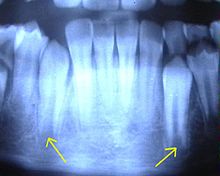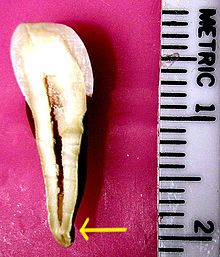Apexification
Under a apexification ( Latin : apex , tip 'suffix -ficatio , producing') is a procedure in dentistry , with an apical to open (at the root tip) root canal is closed before the actual root canal filling. Apexification is mainly used on devitalized (dead) young teeth with not yet completed root growth. With apexification, a natural or artificial hard substance barrier is created at the root tip, depending on the material used.
anatomy
Teeth with complete root growth have an apical constriction at the apex (at the root tip) (narrowed point at the root tip), at which the root canal has the narrowest cross-section due to the accumulation of hard substance. Without this constriction, there is a risk of overfilling the canal when filling a tooth with the root canal, whereby material could get into the surrounding apical tissue, the bones and - in the case of treatment in the upper jaw - also into the maxillary sinus.
Procedure
Basically, the procedures of a regular root canal treatment must be observed. The apexification itself takes place with calcium hydroxide or with mineral trioxide aggregate (MTA). Therapy with MTA is much more difficult, as overfilling this non-resorbable material must be avoided, which can lead to an inflammatory foreign body reaction. If the material calcium hydroxide (Ca (OH) 2 ) is overfilled, however, the possibly excess material is absorbed .
Calcium hydroxide
Calcium hydroxide stimulates the natural formation of hard substance at the root tip over a period of 6 to 18 months. Calcium hydroxide reactively and slowly stimulates the regeneration of hard tooth substance via its strongly basic pH value . After an X-ray detectable apexification, the final root canal filling can be carried out relatively safely with regard to undesired overfilling.
Mineral trioxide aggregate
When using MTA, an artificial hard substance barrier is created. The material hardens within a few hours to form a solid cement seal in the root canal in the area of the root tip. The manufacture of this sealing plug at the end of the root canal requires multiple, exact length measurements of the canal and a step-by-step approach to avoid overfilling. The definitive remaining root canal filling can be done on the following day.
forecast
The success rate of apexification by means of Ca (OH) 2 is given as 74% to 98% depending on the study; for MTA it is still questionable, with a good trend.
Further development
The relatively new method of regenerative endodontics aims to bring the root growth to completion by mobilizing stem cells from the area of the apical papilla into the root canal. This means that the closure with Ca (OH) 2 or MTA should no longer be necessary.
literature
- Michael A. Baumann, Rudolf Beer: Endodontology . Georg Thieme Verlag, December 21, 2007, ISBN 978-3-13-155002-6 , p. 363–.
Individual evidence
- ↑ On the prognosis of root canal treatments , DGZMK , November 2000: Retrieved on June 2, 2017.
- ^ T. Weber, Endodontie im Wechselgebiss , Memorix Zahnmedizin. Georg Thieme Verlag 2013. doi: 10.1055 / b-0034-10185 , ISBN 3-13-114373-8 . Retrieved June 2, 2017.
- ^ Michael A. Baumann, Rudolf Beer: Endodontologie . Georg Thieme Verlag, December 21, 2007, ISBN 978-3-13-155002-6 , p. 364.

